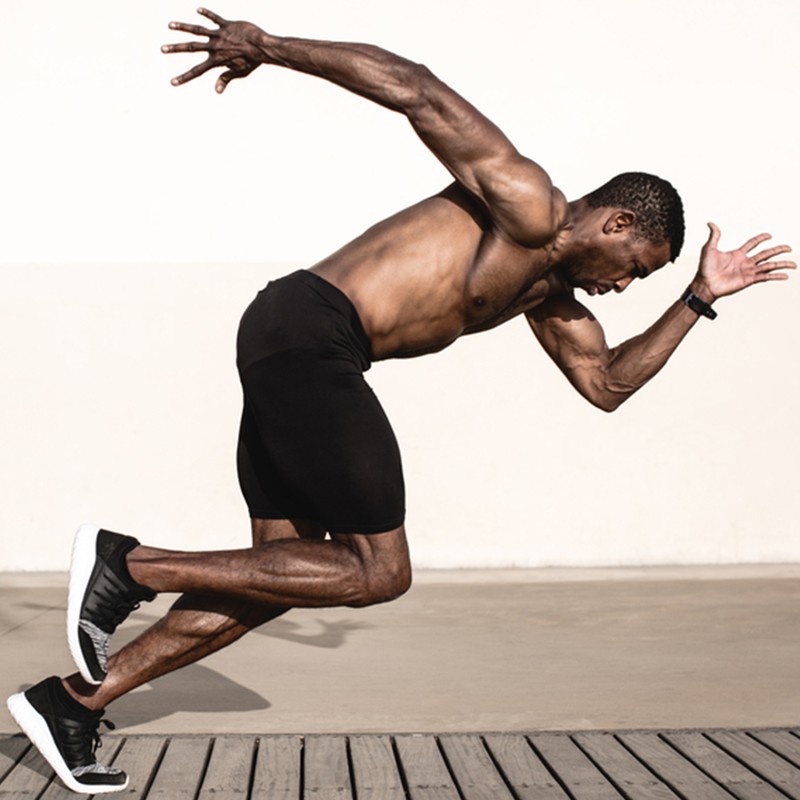7 Things To Know About Your VO2 Max
1. It’s A Reflection Of Fitness…
As Rob McCabe, personal training manager at Equinox, explains, “VO2 is a measure of your aerobic fitness – of how much oxygen you use when going at full tilt.” Its unit of measurement is millilitres of oxygen over kilograms of body mass per minute, which looks like this: ml/kg/min. The higher the number, the more conditioned your cardiovascular system is, and the easier a longer workout will feel. “For men aged 26 to 35, a decent VO2 max is anything above 39, while those aged 36 to 45 should aim for a score of at least 36,” says Rob. If you’re looking to shave a few seconds off your 5k PB or run a sub-4hr marathon, a higher VO2 max could help you get there.
2. And Also Of Overall Health
Whether you’re a performance junkie or not, it pays to know your VO2 max because research shows it’s also a reflection of your wider health status. “VO2 max has been shown to be one of the biggest predictors of life expectancy,” confirms Rob. “A higher result will also decrease your risk of cardiovascular disease, diabetes, Alzheimer’s and dementia, as well as improve your resilience when it comes to dealing with stress, and boost your body’s ability to metabolise fats during exercise.”
3. It’s Simple To Work Out
At elite level, VO2 max is measured in a laboratory setting through a maximal running or cycling test. “It’s measured directly via breathing through a mask while exercising at increasingly hard levels for a period of time before fatigue is reached,” explains Alex Nicholl, director of the BXR London gym. In other words, strap on a mask and go hard until you drop. Not an athlete? Don’t worry. Plenty of fitness trackers estimate VO2 max, but it may go by a different name: on Fitbit devices, for example, it’s referred to as a ‘cardio fitness score’. If you want to work yours out, you’ll need to wear your watch for several outdoor activities (ideally running or cycling) as it relies on GPS as well as heart-rate readings. For a reliable result, check your wearable delivers accurate heart rate reports. If you don’t have a decent wearable, there are online calculators that can estimate your level.
4. It’s Worth Tracking Over Time
Your VO2 max is a great snapshot of your fitness. Of course, if you take anything more than a couple of weeks off from training, you will negatively affect your fitness and you would start to see a decline in your VO2 max. According to Rob, “For an elite athlete, this could be around 7%. For a recreational runner, it will be less. Fortunately, it takes less work to maintain your fitness than improve it, so to put the brakes on a slump, drop your workout frequency to just one or two sessions a week and use shorter, more intense interval sessions when you do. This is a great way to maintain fitness when on holiday, for example.”
5. Try Interval Training
If you’re just setting out on your fitness journey, improvements to your VO2 max will come relatively easily through sustained aerobic exercise like running, cycling or swimming. However, as your fitness increases, you’ll need to up the pace to keep seeing results, says Alex. “To keep improving your VO2 max, you’ll need to train at or around that variable, so training slightly above, below or at VO2 max intensity can help. An easy way to do this is by incorporating longer-duration intervals into your workout: for example, working at your max effort for three minutes followed by two minutes at a slower pace, repeated four or five times.”
6. Don’t Get Stuck In a Rut
“One of the biggest mistakes I see people making when it comes to improving their VO2 max is thinking a consistent level of effort will make a difference,” says Rob. “If you’re doing the same fitness class week in, week out, or running the same 5k route at the same intensity, this will do nothing for your fitness levels. The body thrives on adapting to change, so try to mix things up and you will see results.”
7. Recovery Matters
To achieve optimal performance, you need to train hard and recover harder, says Alex. “If you aren’t able to recover fully from your previous sessions, this will stop the body from being able to reach the intensity you need when you work out to see results. Getting adequate sleep, mobility work, Epsom salt baths and contrast showers (where you alternate between hot and cold) are all great ways to boost recovery.”
For more information, visit Equinox.com and BXRLondon.com.
DISCLAIMER: We endeavour to always credit the correct original source of every image we use. If you think a credit may be incorrect, please contact us at [email protected].


